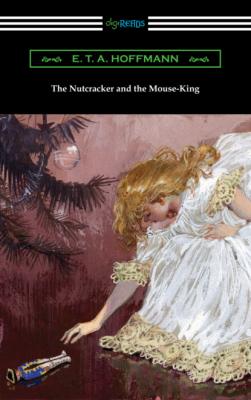The Nutcracker and the Mouse-King. E. T. A. Hoffmann
Читать онлайн.| Название | The Nutcracker and the Mouse-King |
|---|---|
| Автор произведения | E. T. A. Hoffmann |
| Жанр | Зарубежная классика |
| Серия | |
| Издательство | Зарубежная классика |
| Год выпуска | 0 |
| isbn | 9781420971644 |
The Nutcracker and the Mouse-King
By E. T. A. Hoffmann
Translated by Louise F. Encking
Illustrated by Emma L. Brock
Print ISBN 13: 978-1-4209-7163-7
eBook ISBN 13: 978-1-4209-7164-4
This edition copyright © 2020. Digireads.com Publishing.
All rights reserved. No part of this publication may be reproduced, distributed, or transmitted in any form or by any means, including photocopying, recording, or other electronic or mechanical methods, without the prior written permission of the publisher, except in the case of brief quotations embodied in critical reviews and certain other noncommercial uses permitted by copyright law.
Cover Image: a detail of “Clara wakes up and finds her nutcracker”, by Libico Maraja, c. 20th century / © Fototeca Gilardi/Associazione Maraja / Bridgeman Images.
Please visit www.digireads.com
CONTENTS
THE BATTLE OF THE SUGAR BULLETS
THE FAIRY TALE OF THE HARD NUT
CONTINUATION OF THE FAIRY TALE OF THE HARD NUT
CONCLUSION OF THE FAIRY TALE OF THE HARD NUT
FRITZ AND MARIE SAT HUDDLED TOGETHER ON A SOFA.
THE NUTCRACKER
AND
THE MOUSE-KING
ONCE IT WAS A MARIONETTE.
FOREWORD
The story of “The Nutcracker and the Mouse-King” is so full of word pictures that no one in the whole world could draw them all, though each picture is so beautiful and full of color that one can scarcely resist trying to.
Ernst Theodor Amadeus Hoffmann wrote this story in Germany more than a hundred years ago—for his own pleasure, we imagine—and he put into it all the beautiful things he could think of, dolls and castles, candies and candles, crimson lakes and sparkling gardens and hundreds and hundreds of fairy people, and comical people too.
The story is most exciting, all about the long battle between the Nutcracker and the Mouse-King with his seven heads and seven golden crowns, the battle that with Marie’s help ended in victory for the Nutcracker. To show his gratitude for her kindness, the Nutcracker takes Marie through her father’s overcoat sleeve to the Land of Dolls.
It is in this part of the book that the author has the greatest fun making word pictures. There is Lemonade River, villages of sugar cookies and transparent candy, gates of almonds and raisins, confetti forests, thousands of little people shouting, laughing and joking; and everywhere a fragrance of oranges and roses.
The gay imaginings in the book, especially those in the Land of Dolls, amused Peter Tchaikovsky, the great Russian musician, and he has written the music of “The Nutcracker Suite” all about this tale. The Chinese dance, the waltz of the Flowers and the dance of the Sugar Plum Fairy are all drawn from these chapters of Marie’s visit to Toy Land with the Nutcracker. And you can see the gay little people when you hear the music, just as you can when you read the story.
We two who have been translating the story and doing the drawings enjoyed ourselves more than tongue can tell. Now you begin the book and see how happy you are.
EMMA L. BROCK.
HUNDREDS OF LIGHTS SPARKLED LIKE LITTLE STARS.
THE NUTCRACKER AND THE MOUSE-KING
Godfather Drosselmeier.
THE DAY BEFORE
It was the day before Christmas. Fritz; and Marie Stahlbaum sat huddled together on a sofa in a little back room, for they had been forbidden to go near the living room or the drawing room. Fritz; was whispering very secretly to Marie. “Early this morning,” he told her, “I heard all kinds of noises,—rustling of paper and pounding behind the locked rooms.” Also, he confided to her, “I saw a small, dark man, with a large box under his arm, glide noiselessly through the hall.”
“Who could that have been?” asked Marie.
“Why, Godfather Drosselmeier! who else could it have been?”
At this Marie clapped her little hands for joy, and exclaimed, “Oh, what kind of a beautiful toy can it be that Godfather has made for us this year?”
Judge Drosselmeier was not a handsome man. He was short and thin, and his face was full of wrinkles. Over his right eye he wore a large black patch and as he had lost all his hair, he wore a beautiful white wig. To be sure, the children knew that Godfather was a very skillful man, for he not only understood clocks but he also made some himself.
This was the reason that whenever one of the clocks became ill and could not sing any more, they sent for Godfather Drosselmeier. He would come, remove his wig and his little yellow coat, and tying on an apron, would take out a pointed instrument and run it into the clock. This always made little Marie sad, but seemed to help the clock, as it at once became alive again and began to purr, to strike and to sing, to the great
